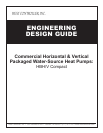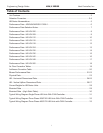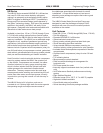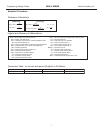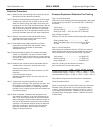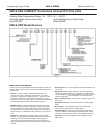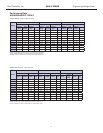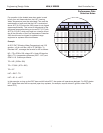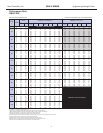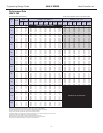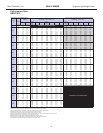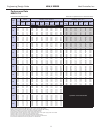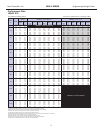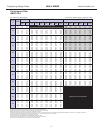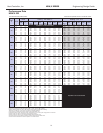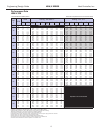
Heat Controller, Inc. HBH/V SERIES Engineering Design Guide
Selection Procedure
Step 1 Determine the actual heating and cooling loads at the
desired dry bulb and wet bulb conditions.
Step 2
Obtain the following design parameters: Entering water
temperature, water ow rate in GPM, air ow in CFM,
water ow pressure drop and design wet and dry bulb
temperatures. Air ow CFM should be between 300 and
450 CFM per ton. Unit water pressure drop should be
kept as close as possible to each other to make water
balancing easier. Go to the appropriate tables and nd
the proper indicated water ow and water temperature.
Step 3 Select a unit based on total and sensible cooling
conditions. Select a unit which is closest to, but no
larger than, the actual cooling load.
Step 4 Enter tables at the design water ow and water
temperature. Read the total and sensible cooling
capacities (Note: interpolation is permissible,
extrapolation is not).
Step 5 Read the heating capacity. If it exceeds the design
criteria it is acceptable. It is quite normal for Water-
Source Heat Pumps to be selected on cooling capacity
only since the heating output is usually greater than the
cooling capacity.
Step 6 Determine the correction factors associated with the
variable factors of dry bulb, wet bulb and air ow.
Corrected Total Cooling =
tabulated total cooling x wet bulb correction x air ow
correction
Corrected Sensible Cooling =
tabulated sensible cooling x dry bulb correction x air
ow correction
Step 7 Compare the corrected capacities to the load
requirements. Normally if the capacities are within 10%
of the loads, the equipment is acceptable. It is better
to undersize than oversize, as undersizing improves
humidity control, reduces sound levels and extends the
life of the equipment.
Step 8 When completed, calculate water temperature rise
and assess the selection. If the units selected are not
within 10% of the load calculations, then review what
effect changing the GPM, water temperature and/or air
ow and air temperature would have on the corrected
capacities. If the desired capacity cannot be achieved,
select the next larger or smaller unit and repeat the
procedure. Remember, when in doubt, undersize
slightly for best performance.
Example Equipment Selection For Cooling
Step 1 Load Determination:
Assume we have determined that the appropriate cooling load
at the desired dry bulb 80°F and wet bulb 65°F conditions is
as follows:
Total Cooling ......................................23,700 BTUH
Sensible Cooling .................................16,500 BTUH
Entering Air Temp .... 80°F Dry Bulb / 65°F Wet Bulb
Step 2 Design Conditions:
Similarly, we have also obtained the following design parameters:
Entering Water Temp .......................................90°F
Water Flow (Based upon 10°F rise in temp.) 6.0 GPM
Air Flow ....................................................800 CFM
Step 3, 4 & 5 HP Selection:
After making our preliminary selection (TC024), we enter the
tables at design water ow and water temperature and read
Total Cooling, Sens. Cooling and Heat of Rej. capacities:
Total Cooling .......................................23,400 BTUH
Sensible Cooling .................................17,500 BTUH
Heat of Rejection ................................30,200 BTUH
Step 6 & 7 Entering Air and Airow Corrections:
Next, we determine our correction factors.
Table Ent Air Air Flow Corrected
Corrected Total Cooling = 23,400 x 0.9681 x 1.0050 = 22,767
Corrected Sens Cooling = 17,500 x 1.1213 x 0.9820 = 19,270
Corrected Heat of Reject = 30,200 x 0.9747 x 1.0434 = 30,713
Step 8 Water Temperature Rise Calculation & Assessment:
Actual Temperature Rise 10.2°F
When we compare the Corrected Total Cooling and Corrected
Sensible Cooling gures with our load requirements stated
in Step 1, we discover that our selection is within +/- 10% of
our sensible load requirement. Furthermore, we see that our
Corrected Total Cooling gure is within 1,000 Btuh the actual
indicated load.
4



